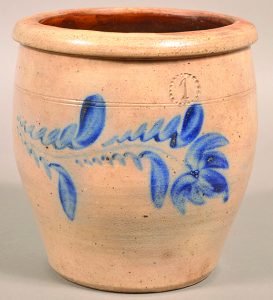ANTIQUES AND COLLECTING: Stoneware crocks with markings are more valuable
By Terry and Kim Kovel — February 27, 2022
This 1-gallon stoneware crock has the impressed mark of Daniel Shenfelder pottery, proving it was made about 1870 in Pennsylvania.
There were many small potteries making stoneware and other ceramics for use in the kitchen, bedroom or farm. Most utensils made in America by the 1800s were made with thick pottery sides in simple shapes with almost no decoration.
The most expensive examples collected today have a design or name on the crock to trace for the age and maker. But unsigned pieces are often identified when sold at auctions. That takes an expert; a family legend is not enough.
Conestoga Auction Company often sells antique and vintage stoneware. Is the side curved or straight? Is there a shaped rim? Is the interior glazed in the same color as the outside or is the inside different? Are there quirks in the shaping of the bottom? These clues can be recognized from a picture, but contact the auction and ask how they knew the maker of the unsigned piece.
This crock is similar to others attributed to Shenfelder Pottery of Reading, Pennsylvania. It has an impressed mark of the numeral “1” inside a coggle wheel circle. It has a blue hand-painted leafy branch on the outside. “Daniel Peter Shenfelder Reading Pa.” is a known mark. The Conestoga catalog said it was “attributed,” not definitely identified, but the auction house is close to the pottery building and has sold many stoneware utensils. This crock sold for $170 after 10 bids.
***
Q: How can I tell new from old milk glass?
A: Antique bottles have become collectors’ items, especially those made in rare colors. Less-expensive bottles with secure closures were used by the 1930s. Milk glass bottles with attractive women’s portraits as the label-under-glass were often the decorations in a Victorian barber shop. Modern copies have been made. Old milk glass is opaque and may be pure white, pale green, robin’s-egg blue, pink or black. Milk glass was not used for dinner plates but was used for doorknobs, lamps, vases and knickknacks like salt and peppers. They even made reusable figural milk glass store contains for mustard. When buying, look at milk glass carefully. Old glass is smooth and often marked with a shape or pattern number. There are many vintage and new copies that sell for very low prices.
***
CURRENT PRICES
Souvenir tablecloth, California, yellow map, cities, multicolor drawings of famous landmarks, turquoise ground, red scallop border, cotton, 1950s, 50 inches square, $85.
World’s Fair, lamp, New York World’s Fair 1939, frosted glass plate with Trylon & Perisphere, square stepped base, electric, bulb sits behind plate, 7 inches, $240.
Kitchen, butter churn, wood, stave construction, metal bands, original blue paint, pole in center, 1800s, $490.
Advertising, trade sign, boot, figural, sheet iron, tall shaft, stacked heel, painted black and orangey tan, western detailing, late 1800s, 26 1/4 inches, $780.
***
TIP: Use protector pads on the bottom of furniture feet. Replace them periodically when they become dirty or very flat.
Looking to declutter, downsize or settle an estate? Kovels’ Antiques & Collectibles Price Guide 2021 by Terry and Kim Kovel has the resources you’re looking for.
© 2021 King Features Synd., Inc.
ANTIQUES AND COLLECTING: Sources disagree on origin of whirligigs
ANTIQUES AND COLLECTING: Decorative bottles are prized by collectors



